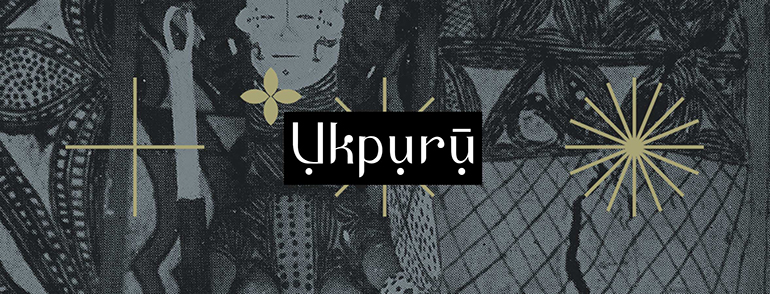
A blacksmith, ọkpụ ụzụ, and his nwa ụzụ, an apprentice blacksmith. The first job given to a young Igbo blacksmith was to attend to the eko, bellows (pictured) and to do menial tasks like fetching fuel, all while watching and learning from the master blacksmith, the nna ụzụ at work. The nna ụzụ was truly like an nna (father) to the boy whose well-being he was responsible for, including ensuring the upkeep of the boys spiritual care and making prayers and sacrifices to the boys chi when taking trips. Parents kept a watchful eye on the treatment of their apprentice child and could withdraw or transfer their child at any time if there were any concerns over their treatment (or mistreatment).
After they gain some experience, the first work an apprentice got with working with metal was making small chains from brass and other scrap metal; the experienced blacksmiths of the past smithed and produced igwe aga, pig-iron, from iron ore, nne igwe, obtained locally. In Alaigbo (Igbo land), the best known smithing centres were at Awka, Nkwere, and Abiriba; Awka dominated blacksmithing in north-central Alaigbo and Akwa smiths were said to have spent most of their time abroad for work which included areas far outside of Alaigbo [as J. S. Boston (1964) noted, Awka blacksmiths dominated smithing at Igala land, for instance], their work and trading times were scheduled by seasons.
Awka people were generally skilled artisans and long-distance traders (especially of ivory, they had many ivory hunting groups) hence their name, Ọ́ká, meaning artisan or skilled one; they were also well known for being dibia as well as for crafting amulets and making other religious paraphernalia, sometimes even erecting shrines. Awka dominated in wood carving, particularly of wooden screens and the mgbo ezi, the wooden gate once used as the main entrance to a family compound in old times found in museums around the world today, and other items like titled mens stools. The Agulu village-group of Awka, in order to get a competitive edge, had developed the ivu aba private language used by Awka smiths which flipped Igbo words and developed new terms all together. In Awka, nwa ụzụ were usually Awka boys in their early teens who were strong enough for the tasking work at hand; the boys were related to the ọkpụ ụzụ, rarely were non-Awka boys taken under apprenticeship, since the late 20th century, however, this has changed and non-Awka can now enter smithing guilds. Awka blacksmiths were often part of an otu ụzụ, a blacksmithing guild headed by an nna ụzụ (in Awka it is said that the master blacksmith may actually be referred to as nnẹ ụzụ) who led and managed the smiths in workshops, acting as a counsellor who settled tensions and disputes. A workshop was usually a section of a guild and they were small, including less than a dozen workers. Blacksmiths could also travel to work for themselves to supplement their income.
By the 1950s interest in apprenticeships in blacksmithing started to decline, today blacksmithing at Awka is underfunded and under the threat of disappearing, older blacksmiths say that the trade in no longer attractive to young people since it has become less of an economically viable trade.
Photo: “A blacksmith at work” by G. T. Basden, early 20th century, coloured by Ụ́kpụ́rụ́ 2017.



